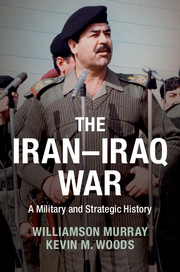Book contents
- Frontmatter
- Dedication
- Contents
- List of figures
- List of tables
- Preface
- Acknowledgments
- Note to reader
- 1 Introduction
- 2 A context of “bitterness and anger”1
- 3 The opponents
- 4 1980: The Iraqi invasion begins
- 5 1981–1982: Stalemate
- 6 Defeat and recovery
- 7 1983–1984: A war of attrition
- 8 1985–1986: Dog days of a long war
- 9 1987–1988: An end in sight?
- 10 Conclusion
- Appendix A Timeline
- Appendix B People
- Appendix C Place names
- Appendix D Order of battle
- Bibliography
- Index
- References
6 - Defeat and recovery
Published online by Cambridge University Press: 05 September 2014
- Frontmatter
- Dedication
- Contents
- List of figures
- List of tables
- Preface
- Acknowledgments
- Note to reader
- 1 Introduction
- 2 A context of “bitterness and anger”1
- 3 The opponents
- 4 1980: The Iraqi invasion begins
- 5 1981–1982: Stalemate
- 6 Defeat and recovery
- 7 1983–1984: A war of attrition
- 8 1985–1986: Dog days of a long war
- 9 1987–1988: An end in sight?
- 10 Conclusion
- Appendix A Timeline
- Appendix B People
- Appendix C Place names
- Appendix D Order of battle
- Bibliography
- Index
- References
Summary
Despite all of the improvements in the Iranian situation … they will weaken and deteriorate … The zeal of the Khomeini Guards cannot [continue] to grow … The zeal of the volunteers can only be less than before and so will their number … These are basic principles.
– Saddam HusseinDuring the first half of 1981, Iranian political and military leaders crafted plans to break Iraq’s hold on Abadan and retake Khorramshahr. Their efforts occurred, while various counterrevolutionary factions tried to gain support in Iran’s cities, as leftist guerrillas and assorted terrorists attempted to overthrow Khomeini’s theocratic regime. Over the course of the year, the ayatollahs confronted a ferocious terrorist bombing campaign waged by the People’s Mojahedin, a leftist revolutionary group once allied with Khomeini. On 28 June 1981, two bombs destroyed Khomeini’s political party headquarters in downtown Tehran, killing the party’s leader, Ayatollah Seyyed Mohammad Hosseini Beheshti, fourteen ministers, and twenty-seven deputies. The assassination attempts continued apace in summer 1981. In early July, Iraqi intelligence reported that seventy-one deputies and members of the Shura council “including four ministers” had been assassinated, all of which gave the analysts hope that Khomeini’s regime would not last. One authority on Iran has described Beheshti as the potential Lenin of the Islamic Revolution. The loss of this competent, relatively young revolutionary leader likely helped keep Iran’s wartime leadership from solidifying around a strong leader below the detached Khomeini.
In another attack on 30 August, the People’s Mojahedin assassinated both the president of Iran and the prime minister. In June alone, terrorists assassinated nearly 1,000 senior governmental officials and clergy including the chief justice and the prosecutor general. Nevertheless, the regime’s operatives were even more deadly. During June, they executed nearly 6,000 activists and those whom they described as terrorists. The People’s Mojahedin also made the mistake of directly confronting the army and the Pasdaran, which helped the regime’s efforts to tame the violence. By the end of the summer, Khomeini was securely in power, while his operatives had largely broken leftist and liberal opposition.
- Type
- Chapter
- Information
- The Iran–Iraq WarA Military and Strategic History, pp. 171 - 204Publisher: Cambridge University PressPrint publication year: 2014



